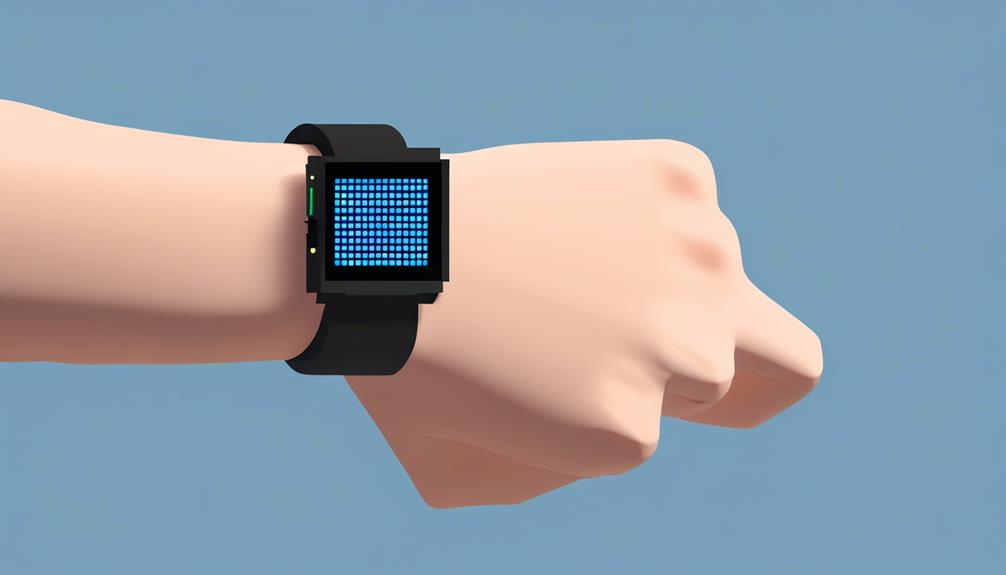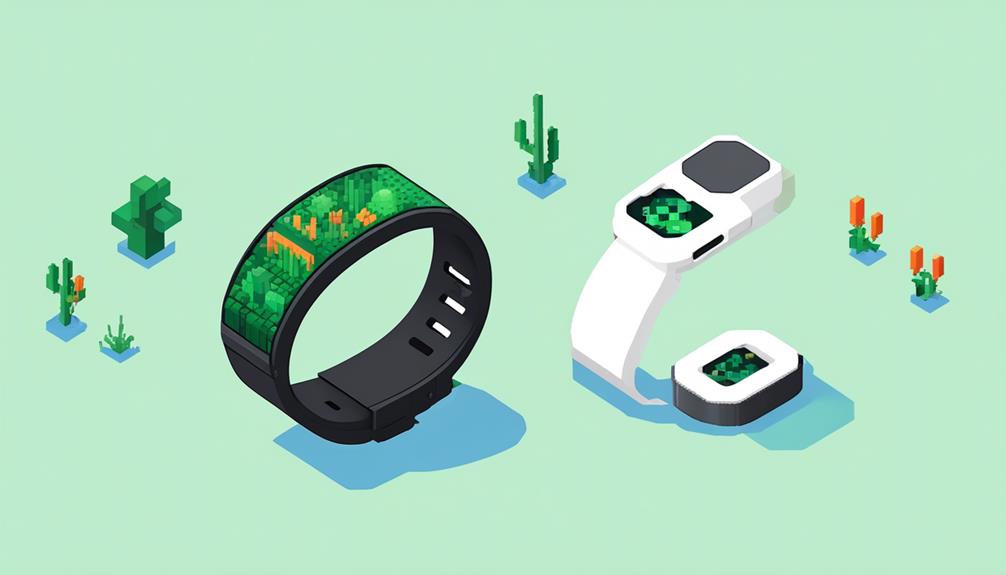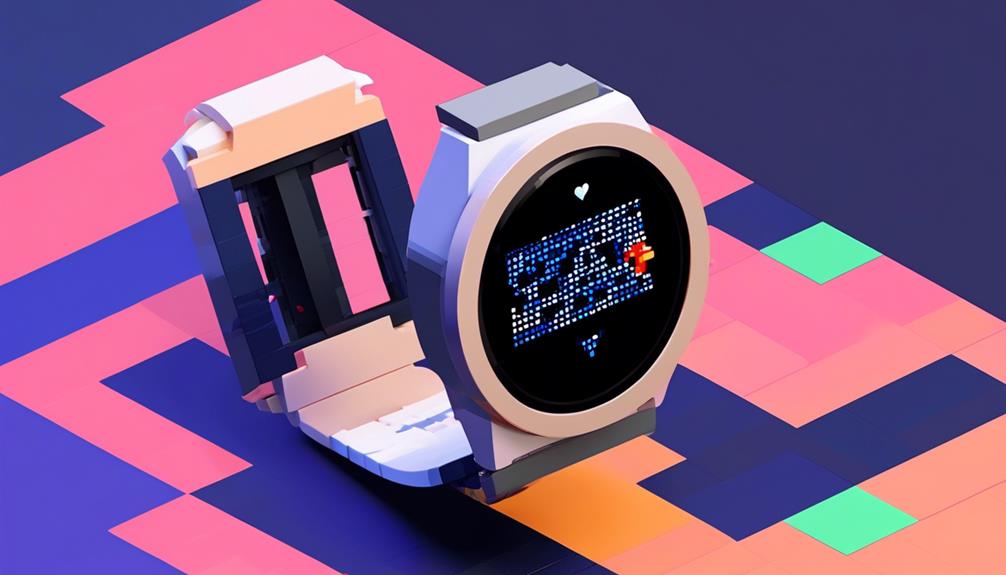Wearable IoT devices have become an integral part of our lives, offering a seamless integration of technology into our daily routines. The rapid advancements in hardware innovations are transforming these devices into powerful tools that enhance our convenience, safety, and productivity.
From miniaturized IoT sensors to advanced biometric measurements, energy-efficient hardware designs to embedded artificial intelligence, the possibilities seem limitless. However, the true potential lies in the untapped possibilities of gesture and motion control, interactive display technology, and secure data transmission.
In this discussion, we will explore the groundbreaking hardware innovations in wearable IoT devices and their potential impact on various industries. Hold on tight as we embark on a journey into the future of wearable IoT devices.
Key Takeaways
- Miniaturized IoT sensors enable the integration of multiple sensors into small wearable devices, expanding their capabilities for health monitoring and data collection.
- Advanced biometric measurements provide more accurate and detailed information about the user's health and well-being, allowing for personalized insights and recommendations.
- Real-time health monitoring allows users to track and monitor their health status continuously, providing early detection of potential issues and enabling proactive intervention.
- Energy-efficient hardware designs are crucial for wearable IoT devices to ensure longer battery life and improve overall usability and convenience for users.
Miniaturized IoT Sensors

Miniaturized IoT sensors are compact, low-power devices embedded with sensors and connectivity, enabling seamless data collection in confined spaces for various wearable applications. These miniaturized sensors play a crucial role in the development of wearable IoT devices, as they allow for accurate and real-time monitoring of user health metrics, environmental conditions, and activities.
By integrating miniaturized IoT sensors into wearable devices, such as smart rings, smart shoes, and smart clothing, users can conveniently track and analyze their vital signs, body movements, and surrounding environmental factors. These sensors contribute to the miniaturization and portability of IoT-enabled wearables, ensuring user comfort and convenience.
One of the key advantages of miniaturized IoT sensors is their small form factor, which allows for discreet and unobtrusive integration into wearables. This ensures that the sensors do not interfere with the user's daily activities and does not compromise the aesthetics of the wearable device. The seamless integration of these sensors into wearables also facilitates accurate data collection, providing users with precise insights and personalized feedback.
Additionally, miniaturized IoT sensors enable wearables to operate in confined spaces where larger devices would be impractical or cumbersome. This opens up possibilities for wearable applications in various industries such as healthcare, sports, and fitness. The use of miniaturized sensors in wearables also promotes the advancement of hardware innovations, as manufacturers continuously strive to develop smaller, more efficient, and more powerful sensors to enhance the performance of wearable IoT devices.
Advanced Biometric Measurements
Advanced biometric measurements in wearable IoT devices offer enhanced biometric accuracy, enabling precise tracking of health and wellness metrics.
With real-time health monitoring capabilities, these devices provide continuous insights into vital signs such as heart rate variability, blood oxygen levels, and stress indicators.
Users can benefit from personalized data insights, allowing for tailored recommendations and the development of personalized healthcare and fitness solutions.
Enhanced Biometric Accuracy
Enhanced biometric accuracy in wearable IoT devices revolutionizes the precision and reliability of biometric data collection, allowing for advanced tracking of health parameters and providing valuable insights for personalized health monitoring and diagnostic capabilities. This smart technology brings forth several key benefits:
- Improved health tracking: Advanced sensors and algorithms enable more accurate measurements of vital signs such as heart rate, blood pressure, and respiratory rate. This ensures that health data collected is reliable and can be used for accurate analysis.
- Continuous patient monitoring: Enhanced biometric accuracy is particularly beneficial in healthcare wearables, as it allows for continuous and reliable monitoring of patients. This enables healthcare professionals to have real-time access to patient data, enhancing patient care and treatment outcomes.
- Enhanced security: The technology also contributes to improved security and authentication features in wearable IoT devices. Biometric data, such as fingerprints or facial recognition, can be used for secure access control, ensuring only authorized individuals can access the device or sensitive information.
- Personalized insights: With enhanced biometric accuracy, wearable devices can provide more personalized insights into an individual's health. This allows for better monitoring and management of chronic conditions, as well as early detection of potential health issues.
Real-Time Health Monitoring
Real-Time Health Monitoring (Advanced Biometric Measurements) revolutionizes the way vital signs and health metrics are continuously tracked and analyzed, providing immediate insights into crucial health parameters for personalized healthcare interventions. This technology enables individuals to monitor their fitness levels and gather accurate information about their health in real-time. Wearable IoT devices equipped with sensors can monitor various biometric measurements, including heart rate, blood pressure, and oxygen saturation levels. The data collected from these devices can be analyzed to detect any abnormalities or patterns that may indicate potential health issues. By providing real-time health monitoring, individuals can take proactive measures to improve their well-being and make informed decisions about their lifestyle choices. The following table illustrates the key biometric measurements that can be monitored using wearable IoT devices:
| Biometric Measurement | Description | Benefits |
|---|---|---|
| Heart Rate | Measures the number of heartbeats per minute | Helps assess cardiovascular health and exercise intensity |
| Blood Pressure | Measures the force of blood against artery walls | Assists in managing hypertension and heart disease risk |
| Oxygen Saturation | Measures the percentage of oxygen in the blood | Helps monitor respiratory health and oxygen levels in the body |
Real-time health monitoring empowers individuals to take control of their health, facilitating early detection of potential health issues and personalized interventions.
Personalized Data Insights
Building upon the foundation of real-time health monitoring, personalized data insights in wearable IoT devices provide comprehensive and individualized health and fitness data for a holistic understanding of one's well-being. These advanced biometric measurements offer insights into gait patterns, symmetry, and speed, allowing for comprehensive health tracking.
The data insights include monitoring blood pressure, calories burned, posture, fatigue, and other crucial health parameters. This valuable information aids in maintaining a healthy lifestyle by offering valuable feedback and personalized coaching.
Wearable IoT devices with advanced biometric measurements are not only affordable but also user-friendly, making them accessible to a wider audience. With the connectivity options offered by innovative wearable IoT devices and the integration of IoT sensors, individuals can now have real-time access to accurate and up-to-date health-related information.
This enables them to make informed decisions and take proactive steps towards improving their overall well-being.
Energy-Efficient Hardware Designs
Energy-efficient hardware designs play a crucial role in optimizing power consumption in wearable IoT devices.
Power-saving chipsets, such as low-power microcontrollers and processors, are employed to minimize energy usage.
Additionally, the integration of energy harvesting technologies and advanced power management techniques further enhance battery life and sustainability in these devices.
Power-Saving Chipsets
Power-saving chipsets, incorporating energy-efficient hardware designs, allow wearable IoT devices to conserve energy and extend battery life. These chipsets optimize the performance of wearables while minimizing power consumption, ensuring prolonged usage.
Here are four reasons why power-saving chipsets are essential for the future of wearable technology:
- Enhanced battery life: By reducing power usage, power-saving chipsets enable wearables to operate for longer periods without the need for frequent recharging.
- Efficient monitoring of physical activity: With extended battery life, wearable devices can continuously monitor heart rate and other physical metrics, providing users with valuable health insights.
- Sustainability: Energy-efficient hardware designs contribute to reducing the environmental impact of wearable devices by conserving energy and reducing the need for frequent battery replacements.
- Improved user experience: Power-saving chipsets ensure that wearables remain functional and reliable throughout the day, allowing users to benefit from uninterrupted connectivity and data tracking.
Low-Energy Connectivity Options
Can wearable IoT devices achieve extended battery life and reduced power consumption through low-energy connectivity options? Absolutely. Low-energy connectivity options, such as Bluetooth Low Energy (BLE) and Zigbee, enable energy-efficient hardware designs for wearable IoT devices. These options allow for the transmission of small data packets over short distances, making them ideal for wearables like fitness trackers, smart glasses, and even medical devices that monitor parameters like blood pressure and adjust medication accordingly. By utilizing low-energy connectivity options, wearable devices can achieve prolonged battery life, ensuring uninterrupted usage for the user. Additionally, these options have minimal impact on the size and weight of the device, maintaining comfort and usability. In the table below, we summarize the benefits of low-energy connectivity options in wearable IoT devices:
| Connectivity Option | Benefits |
|---|---|
| Bluetooth Low Energy (BLE) | Extended battery life, reduced power consumption, suitable for short-range communication |
| Zigbee | Energy-efficient, ideal for transmitting small data packets, low impact on device size and weight |
Battery Life Optimization
The optimization of battery life in wearable IoT devices is achieved through the implementation of energy-efficient hardware designs. These designs are essential for ensuring that devices such as smart shoes and other IoT wearables can operate for extended periods without the need for frequent recharging. To achieve battery life optimization, manufacturers incorporate several hardware innovations:
- Low-power components: The use of low-power processors, memory, and sensors reduces energy consumption, allowing devices to operate for longer durations.
- Optimized circuitry: Carefully designed circuitry minimizes power loss and maximizes energy efficiency, ensuring that every mAh of battery capacity is utilized effectively.
- Advanced power management techniques: Intelligent power management systems regulate power usage based on device activity, optimizing battery life without sacrificing performance.
- Embedded sensors: Integrated sensors accurately monitor vital signs and physical activity, enabling the device to adjust power consumption based on real-time data.
Embedded Artificial Intelligence
Embedded Artificial Intelligence revolutionizes the capabilities of IoT devices by seamlessly integrating AI algorithms and capabilities into their hardware. This technology enables IoT devices, such as smart shoes or business card share devices, to process data, make decisions, and adapt to changing conditions without relying solely on cloud-based or external processing.
By embedding artificial intelligence into IoT devices, a wide range of applications becomes possible. For instance, these devices can be used to enable users to access useful information and make informed decisions in real-time. With embedded AI, IoT devices can analyze data locally, providing immediate responses and reducing the reliance on constant connectivity.
The integration of artificial intelligence into IoT devices also enhances their speed and efficiency. Real-time data analysis and responses become possible, as the device can process information on the spot, without the need for external processing or delays caused by network latency. Furthermore, embedded AI allows these devices to learn and improve their performance over time, based on the data they collect.
Embedded AI is particularly useful in situations where constant connectivity is limited or unreliable. By enabling IoT devices to process data locally, they become more autonomous and responsive, even in environments with limited network connectivity. This opens up new possibilities for IoT devices in various industries, including healthcare, manufacturing, transportation, and more.
Enhanced Connectivity Options

Enhanced connectivity options play a crucial role in enabling wearable IoT devices to establish improved wireless communication and expand network connectivity.
By leveraging technologies such as Bluetooth, NFC, and WiFi, IoT wearables can seamlessly exchange data and communicate with other devices and services.
These enhanced connectivity options facilitate real-time data transmission and synchronization, enhancing the functionality and versatility of wearable IoT devices and enabling seamless interaction and integration with smart home devices and IoT ecosystems.
Improved Wireless Communication
Wearable IoT devices are incorporating advanced wireless communication technologies, revolutionizing connectivity options for seamless integration and improved user experiences. This is achieved through the following advancements:
- Enhanced GPS Tracking: Wearable IoT devices now offer accurate GPS tracking, allowing users to track their physical activity and location in real-time.
- Improved Network Connectivity: With improved wireless communication technologies like Bluetooth 5.0, Wi-Fi 6, and 5G, wearable devices can transfer data faster and connect to a broader range of networks.
- Embedded Sensors: Wearable IoT devices are embedded with sensors that collect data, providing insights into user activities, health, and environmental factors.
- Multi-Connectivity Capabilities: These devices can connect to multiple devices and networks simultaneously, enabling seamless integration and interoperability within the IoT ecosystem.
With these advancements in wireless communication, wearable IoT devices offer enhanced connectivity options, empowering users to stay connected, monitor their health, and improve their overall well-being.
Expanded Network Connectivity
Expanded network connectivity options in wearable IoT devices have revolutionized the way they integrate with other devices and services, opening up new possibilities for seamless integration within the IoT ecosystem.
These enhanced connectivity options enable wearables such as smart shoes, IoT tracking bands, smart clothing, smart watches, smart armbands, and even gaming devices to connect to a wider range of networks, including Wi-Fi, Bluetooth, cellular, and IoT networks.
This expansion in connectivity capabilities allows wearable devices to access real-time data, communicate with other devices, and provide personalized services based on the user's environment.
With expanded network connectivity, wearables can now seamlessly interact with a variety of devices, such as smartphones, smart home appliances, and IoT sensors, resulting in a more integrated and immersive user experience.
Improved Battery Life
The advancement of battery technology in wearable IoT devices has significantly extended their battery life, ensuring uninterrupted usage and reliable performance. Improved battery life has become a crucial aspect of wearable IoT devices, enabling them to meet the demands of various IoT applications, particularly in the areas of health and fitness monitoring.
Here are four reasons why improved battery life is essential for wearable IoT devices:
- Continuous Tracking: Long-lasting battery performance allows wearable devices to continuously track health metrics and physical activities. Users can rely on their devices to provide accurate and real-time data, helping them make informed decisions about their well-being.
- Uninterrupted Monitoring: Enhanced battery technology enables wearable devices to monitor vital signs and other health-related parameters without interruptions. This continuous monitoring is particularly important in healthcare settings, where the devices need to provide critical data for medical professionals.
- Real-time Data Transmission: With extended battery life, wearable IoT devices can transmit data to other devices or the cloud in real-time. This seamless data transfer ensures that users can access their information whenever they need it, enhancing the overall convenience and usability of the devices.
- Versatile Applications: Improved battery efficiency allows wearable IoT devices to be used in various industries and environments. From smart shoes that track running distance and speed to workplace wearables that monitor employee safety, extended battery life supports prolonged use in different settings.
Waterproof and Dustproof Designs

Waterproof and dustproof designs are crucial components in the development of durable and reliable wearable IoT devices, ensuring their longevity and performance in challenging environmental conditions. These designs protect wearables from water damage, allowing them to be used in water-related activities such as swimming, surfing, and diving. They also safeguard against dust, dirt, and debris, making wearables suitable for outdoor and industrial settings.
By incorporating waterproof and dustproof features into wearables, hardware innovations have enhanced their reliability and robustness. Wearables with these designs consistently deliver optimal performance even in harsh environments. Users can engage in various activities without worrying about the damage caused by water or dust.
To provide a visual representation of the impact of waterproof and dustproof designs, consider the following table:
| Wearable Device | Waterproof Rating | Dustproof Rating |
|---|---|---|
| Smartwatch | IP68 | IP6X |
| Fitness Tracker | IP67 | IP5X |
| Smart Shoes | IPX8 | IPX7 |
| Headphones | IPX6 | IPX4 |
| Smart Glasses | IPX5 | IPX3 |
The table depicts different wearable devices along with their waterproof and dustproof ratings. For example, smart shoes have an IPX8 waterproof rating, making them suitable for underwater activities. Additionally, their IPX7 dustproof rating ensures protection against dirt and debris.
Waterproof and dustproof designs in wearable IoT devices offer peace of mind to users, knowing their devices are well-protected. These hardware innovations not only extend the lifespan of wearables but also enable users to maximize their usage in diverse environments.
Real-Time Health Monitoring
Real-time health monitoring through wearable IoT devices revolutionizes healthcare by providing continuous tracking of vital signs and health metrics. This technology offers numerous benefits and applications in the field of healthcare. Here are four key reasons why real-time health monitoring using wearable IoT devices is crucial:
- Early Detection and Prevention: By collecting patient data in real-time, wearable IoT devices enable early detection and prevention of various health conditions. Continuous monitoring of vital signs, such as heart rate, blood pressure, and oxygen levels, allows healthcare professionals to identify any abnormalities or potential health risks promptly. This proactive approach can significantly improve patient outcomes and reduce the likelihood of severe health issues.
- Personalized Healthcare: Wearable IoT devices provide personalized health insights and recommendations based on the collected data. These devices track activity levels, sleep patterns, and other health metrics to offer tailored advice and interventions. By empowering individuals with real-time information about their well-being, wearable IoT devices promote self-care and encourage healthier lifestyle choices.
- Remote Patient Monitoring: Real-time health monitoring using wearable IoT devices enables remote patient monitoring. This technology allows healthcare providers to monitor patients' health conditions from a distance, reducing the need for frequent clinic visits. Remote patient monitoring is particularly beneficial for individuals with chronic illnesses, elderly patients, and those living in rural areas with limited access to healthcare facilities.
- Diverse Applications: Wearable IoT devices have applications beyond healthcare. These devices are widely used in the fitness industry to track physical activity, calories burned, and exercise performance. Additionally, wearable IoT devices are utilized in workplace safety programs to monitor employee health and prevent accidents. The versatility of wearable IoT devices makes them an invaluable tool in various domains, enhancing both individual well-being and overall safety.
Gesture and Motion Control

With the advancement of wearable IoT devices in real-time health monitoring, the next frontier in connectivity lies in the field of gesture and motion control technology. This technology allows users to interact with their devices through hand movements and body gestures, providing a hands-free operation that enhances convenience and accessibility.
Gesture and motion control technology has found applications in various domains, including gaming peripherals, virtual reality systems, and smart home devices. By utilizing sensors, this technology detects and interprets specific gestures and movements, providing a more immersive and interactive user experience.
One application of gesture and motion control technology is in smart shoes. These IoT devices are equipped with sensors that can detect the user's foot movements and translate them into commands. For example, by simply lifting the heel or tapping the toe, users can control various functions such as adjusting the volume, skipping songs, or answering phone calls. This enables a seamless and intuitive user experience, without the need for physical buttons or touchscreens.
In addition to smart shoes, gesture and motion control technology is also being integrated into various wearable devices. These devices, such as smartwatches or fitness trackers, can recognize specific gestures to perform actions like navigating menus, answering calls, or dismissing notifications. This eliminates the need for physical buttons or touchscreens, making the devices more intuitive and user-friendly.
Interactive Display Technology
Interactive display technology revolutionizes the way users engage with devices by allowing active interaction through touch, gestures, and other input methods. This technology has become an integral part of our daily lives, enhancing user experiences and enabling new possibilities. Here are four reasons why interactive display technology is shaping the future of IoT and becoming increasingly popular in wearable devices:
- Enhanced User Experiences: With interactive displays, users can easily navigate through menus, control settings, and interact with content in a more intuitive and immersive way. This technology enables seamless interaction, making smart wearables like smart clothes more user-friendly and accessible.
- Improved Collaboration: Interactive displays allow for real-time collaboration and sharing of information. Wearable devices equipped with interactive displays enable users to collaborate on projects, share ideas, and work together more efficiently, regardless of their physical location.
- Personalized Interactions: Interactive display technology enables personalized user experiences by adapting to individual preferences and needs. Smart wearables equipped with this technology can collect data about users' behaviors and preferences, allowing for tailored content, recommendations, and notifications.
- Integration with Intelligent Technologies: Interactive display technology can be seamlessly integrated with other intelligent technologies like augmented reality (AR) and virtual reality (VR). This integration opens up new possibilities for interactive storytelling, immersive gaming experiences, and enhanced learning and training environments.
As the future of IoT unfolds, interactive display technology will continue to play a crucial role. Its ability to enhance user experiences, facilitate collaboration, enable personalized interactions, and integrate with other intelligent technologies makes it a key component in the development of innovative wearable devices. With ongoing advancements, we can expect to see even more sophisticated and interactive displays in the wearable devices of tomorrow.
Secure Data Transmission

As wearable IoT devices continue to advance in interactive display technology, ensuring secure data transmission becomes paramount for safeguarding sensitive health and personal information. With the increasing use of wearable devices to monitor various aspects of individuals' physical condition, such as heart and respiration rate, stress levels, and time spent on different activities, the need for secure transmission of this data is crucial.
To protect the privacy and integrity of the data transmitted from wearable devices, encryption and authentication methods are employed. These methods ensure that the data is securely transmitted from the wearable device to other connected systems. Secure channels such as SSL/TLS or VPNs are implemented to create a protected environment for data transfer, preventing unauthorized access and potential cyber threats.
Wearable IoT devices utilize secure protocols like HTTPS or MQTT-S to ensure that data is transmitted in a safe and encrypted manner. These protocols establish a secure connection between the wearable device and the receiving system, preventing any malicious interception or tampering of the transmitted data.
Secure data transmission in wearable IoT devices is not only crucial for maintaining privacy but also for enabling secure net file sharing and facilitating advanced features such as facial recognition. By ensuring that sensitive health and personal information is transmitted securely, wearable IoT devices can be trusted as reliable tools for monitoring and improving individuals' well-being.
Frequently Asked Questions
What Are the Innovations in Wearable Devices?
Wearable device trends are witnessing advancements in smart textiles, biometric sensors, augmented reality, and health monitoring capabilities. These innovations are transforming the way we interact with technology, enabling seamless integration into our daily lives.
Fashion forward wearables are becoming increasingly popular, combining style and functionality.
Additionally, wearable device security is a key focus, ensuring the protection of personal data and preventing unauthorized access.
These developments are driving the growth and adoption of wearable IoT devices across various industries.
What Are the 5 Wearable Technologies Today?
Emerging trends in wearable technology include:
- Fitness trackers: These devices monitor various health metrics and provide insights for maintaining a healthy lifestyle.
- Smartwatches: Offering a range of features such as notifications, fitness tracking, and mobile connectivity.
- Virtual reality headsets: Providing immersive experiences for gaming and entertainment.
- Smart clothing: Integrating technology into garments for tracking and analyzing various health parameters.
- Health monitoring devices: Enabling individuals to monitor their vital signs and receive personalized feedback.
- Gesture control technology: Allowing users to interact with devices through hand movements.
How Iot Is Used in Wearable Devices?
The impact of IoT on the wearable device market is significant, as it enables the integration of sensors in these devices for data collection and analytics. This allows for the tracking and monitoring of various health parameters, as well as the enhancement of workplace safety.
Connectivity options, such as Bluetooth and Wi-Fi, enable seamless communication between wearable IoT devices and other devices. IoT also finds applications in fitness wearables, aiding in tracking and improving physical activity.
However, security challenges remain a concern, and future trends in wearable IoT technology include advancements in battery life and miniaturization.
Which Model of Iot Is Popular Among Wearable Iot Devices?
Among wearable IoT devices, the smartwatch model is particularly popular. Smartwatches offer numerous benefits, such as messaging, email management, and calling capabilities, making them versatile devices for communication and productivity.
However, implementing wearable IoT devices faces challenges such as limited battery life and complex connectivity requirements. Security concerns also arise due to the sensitive data collected by these devices.
In healthcare, wearable IoT devices have a significant impact, enabling remote patient monitoring and improving healthcare outcomes.
Future trends include the integration of artificial intelligence for enhanced functionality and the role of data analytics in maximizing the potential of wearable IoT devices.
